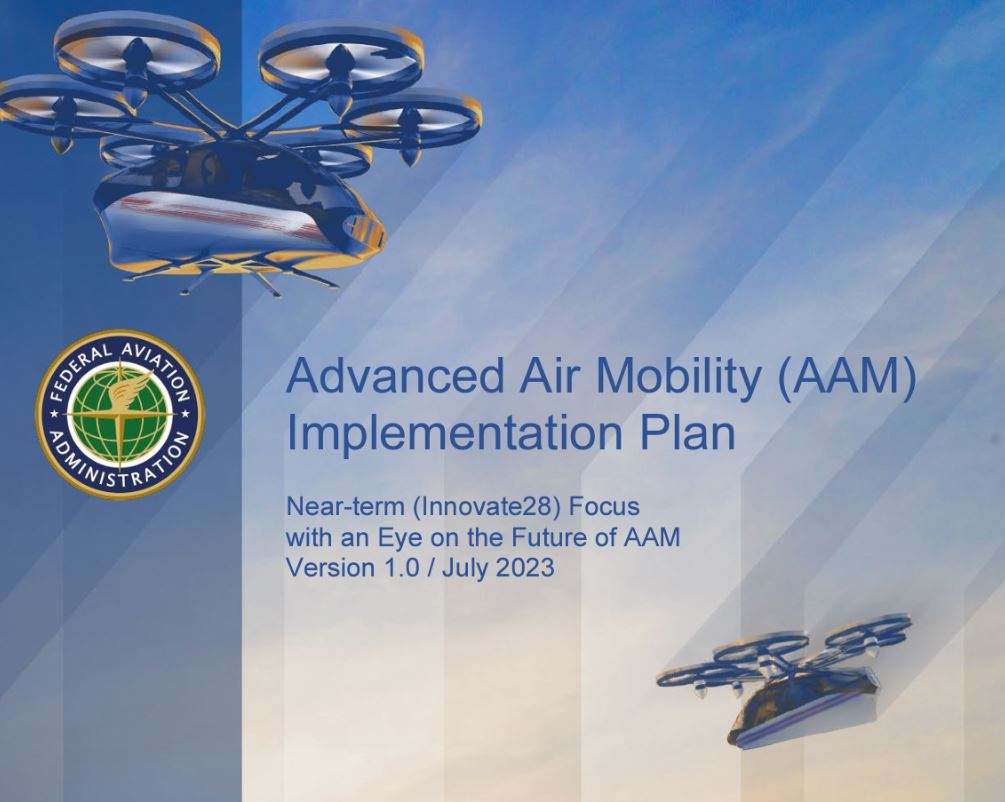
The Federal Aviation Administration (FAA) has published its Advanced Air Mobility (AAM) Implementation Plan Near-term (Innovate28) Focus with an Eye on the Future of AAM report, which sets out a high-level view on how urban and advanced air mobility services will be deployed in the USA by 2028, the Innovate28 (I28) timeline.
According to the FAA:
“Innovate28 (I28) is an FAA initiative that will culminate in integrated AAM operations with OEMs and/or operators flying between multiple origins and destinations at one or more locations in the U.S. by 2028. I28 marks one milestone on the AAM evolutionary continuum and the path to full integration and operations at scale across the NAS.”
The document’s high-level vision gives an important overview of how UAM/AAM first operations will be delivered – broadly relying on current ATC and ground infrastructure. For planners of the first commercial services looking at early-stage developments, the document provides a clear view of operational concepts in areas which are under the agency’s direct remit. But it is also clear that the limits to the FAA’s remit in many areas of the AAM eco-system have not yet been fully established, especially in areas such as vertiport development.
For example: “Initial AAM operations in the 2025-2028 timeframe are expected to primarily use existing airports and heliports (with modification where required to meet FAA’s interim guidance for vertiport design)…. It is unlikely, but possible, that specially built vertiports will be available in this timeframe.”
Many of the first planned eVTOL services in the USA will be developed around networks of new vertiports and it is unclear whether I28 will encourage first adopters to base initial operations on existing heliports and regional airports – where there is clear FAA oversight – or build their own. As the FAA’s role in overseeing new vertiport development is limited, building your own vertiport could involve considerably less, or considerably more, regulatory oversight, depending on the view of the local municipal authority.
So… “Communities, developers, and operators may also choose to establish new vertiports, not co-located with an existing airport or heliport. State licensing and local zoning ordinances may require updates to accommodate these new types of landing facilities. Where no federal funding is used, FAA oversight and engagement with these new vertiports and their surrounding communities may be limited.”
Further: “Additional aspects of infrastructure will need to be addressed as I28 efforts progress, including electrification to support charging of AAM aircraft and power for AAM operations. The DOT Interagency Working Group will address these and other topics not directly in the FAA’s purview.”
The issue of how flow-control measures will be introduced into the ATM system so eVTOLs will not need to expend precious reserves of energy hovering beside a vertiport waiting for a landing slot is raised, but not addressed, as is the issue of how possible likely congestion in VFR airspace will be managed.
“In cases where existing VFR procedures do not meet the needs of air traffic facilities or AAM operators, special agreements or coordination may need to occur to accommodate the increase in traffic levels. Ideally, agreements made at the local level will reduce ATC workload.”
Assigning responsibility for AAM routes will clearly be a complex process, involving negotiations between local ATC services and aircraft operators on the basis of existing airspace architecture, with the FAA making clear it will not become involved in assigning new AAM routes itself:
“The development of airspace route structures for I28 operations will consider design standards based on 14 CFR parts 135 and 91, General Operating and Flight Rules, local procedures, terrain, and traffic flows. Pilot adherence to charted I28 routes and the recommended altitudes or flight ceilings associated with them are voluntary. However, ATC may assign charted routes and altitudes where pilot compliance is required, provided such procedures are called for in specific FAA-operator Letters of Agreement (LOAs), or are necessitated by traffic density and/or safety considerations.”
But..
“I28 AAM routes may include non-published routes. They may also require development of new routes. More information is needed to make this determination; it may be a combination of existing and new route structures until a specific AAM route process can be developed. It is important to note, however, that no unique AAM airspace structures (e.g., dedicated AAM airspace corridors) or procedures are expected to be implemented by this 2028 timeframe.”
Again, identifying approach and departure routes into vertiports based on negotiations with local ATC services could be a relatively simple procedure but it could also be extremely complex, especially as many eVTOL operators will want to scale their operations very quickly.
None of these issues are deal-breakers – but, predictably, the closer we get to real commercial eVTOL operations the more complex the institutional and regulatory issues become, especially if they involve non-aviation stakeholders.
For more information
https://www.faa.gov/sites/faa.gov/files/AAM-I28-Implementation-Plan.pdf

